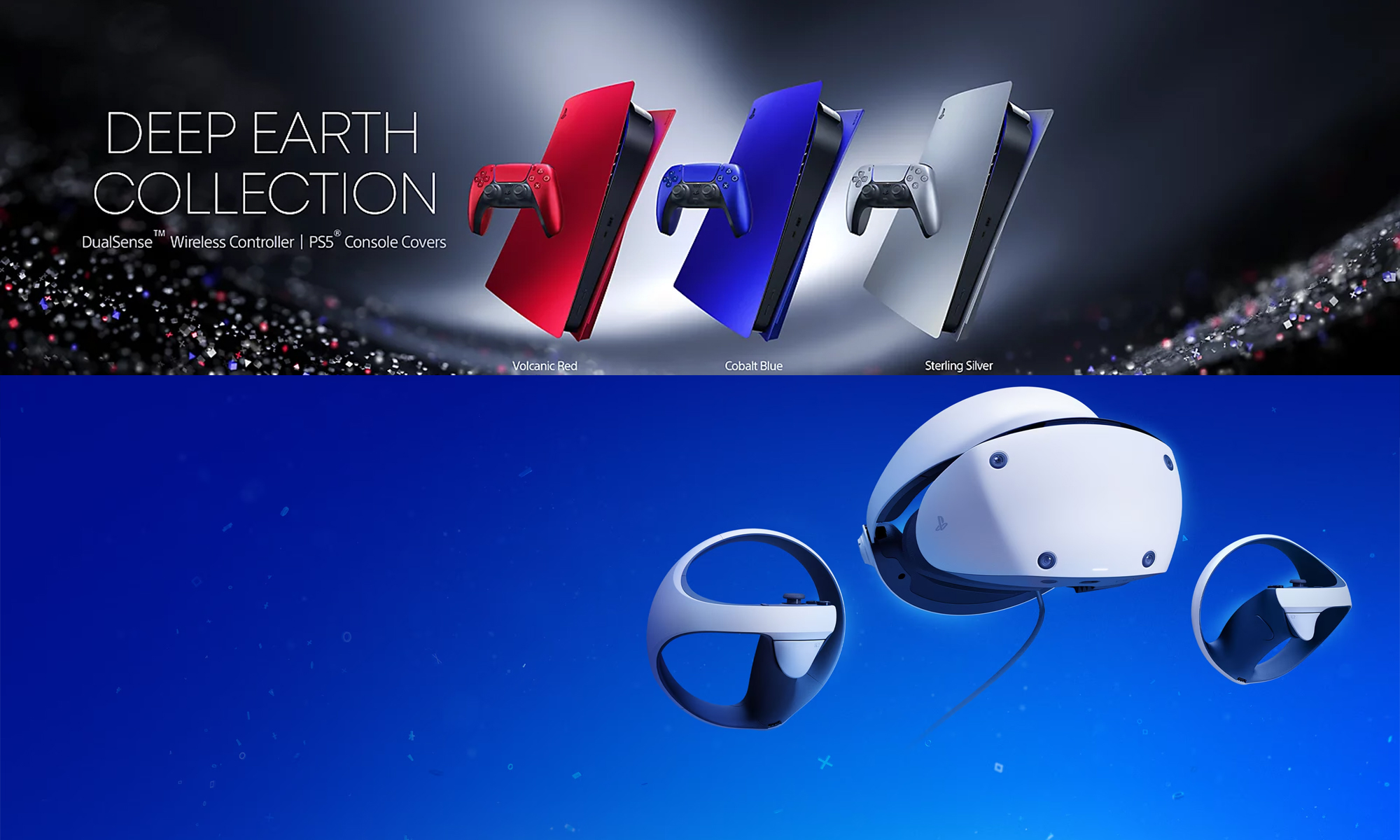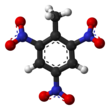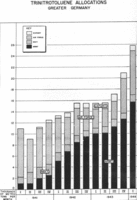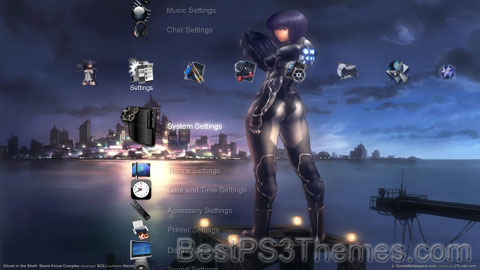TNT theme by TNT
Download: TNT_2.p3t
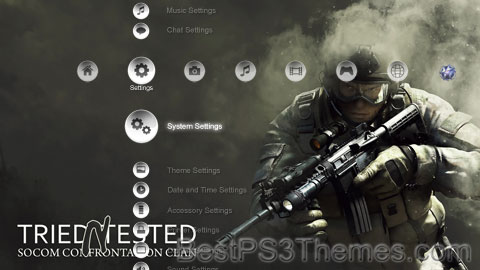
(1 background)
| |||
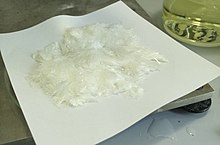
| |||
| Names | |||
|---|---|---|---|
| Preferred IUPAC name
2-Methyl-1,3,5-trinitrobenzene[citation needed] | |||
Other names
| |||
| Identifiers | |||
3D model (JSmol)
|
|||
| Abbreviations | TNT | ||
| ChEMBL | |||
| ChemSpider | |||
| DrugBank | |||
| ECHA InfoCard | 100.003.900 | ||
| EC Number |
| ||
| KEGG | |||
PubChem CID
|
|||
| RTECS number |
| ||
| UNII | |||
| UN number | 0209 – Dry or wetted with < 30% water 0388, 0389 – Mixtures with trinitrobenzene, hexanitrostilbene | ||
CompTox Dashboard (EPA)
|
|||
| |||
| |||
| Properties | |||
| C7H5N3O6 | |||
| Molar mass | 227.132 g·mol−1 | ||
| Appearance | Pale yellow solid. Loose "needles", flakes or prills before melt-casting. A solid block after being poured into a casing. | ||
| Density | 1.654 g/cm3 | ||
| Melting point | 80.35 °C (176.63 °F; 353.50 K) | ||
| Boiling point | 240.0 °C (464.0 °F; 513.1 K) (decomposes)[1] | ||
| 0.13 g/L (20 °C) | |||
| Solubility in ether, acetone, benzene, pyridine | soluble | ||
| Vapor pressure | 0.0002 mmHg (20°C)[2] | ||
| Explosive data | |||
| Shock sensitivity | Insensitive | ||
| Friction sensitivity | Insensitive to 353 N | ||
| Detonation velocity | 6900 m/s | ||
| RE factor | 1.00 | ||
| Hazards | |||
| GHS labelling: | |||
   
| |||
| Danger | |||
| H201, H301, H311, H331, H373, H411 | |||
| P210, P273, P309+P311, P370+P380, P373, P501 | |||
| NFPA 704 (fire diamond) | |||
| Lethal dose or concentration (LD, LC): | |||
LD50 (median dose)
|
795 mg/kg (rat, oral) 660 mg/kg (mouse, oral)[3] | ||
LDLo (lowest published)
|
500 mg/kg (rabbit, oral) 1850 mg/kg (cat, oral)[3] | ||
| NIOSH (US health exposure limits): | |||
PEL (Permissible)
|
TWA 1.5 mg/m3 [skin][2] | ||
REL (Recommended)
|
TWA 0.5 mg/m3 [skin][2] | ||
IDLH (Immediate danger)
|
500 mg/m3[2] | ||
| Safety data sheet (SDS) | ICSC 0967 | ||
| Related compounds | |||
Related compounds
|
picric acid hexanitrobenzene 2,4-Dinitrotoluene | ||
Except where otherwise noted, data are given for materials in their standard state (at 25 °C [77 °F], 100 kPa).
| |||
Trinitrotoluene (/ˌtraɪˌnaɪtroʊˈtɒljuiːn/),[4][5] more commonly known as TNT (and more specifically 2,4,6-trinitrotoluene), and by its preferred IUPAC name 2-methyl-1,3,5-trinitrobenzene,[citation needed] is a chemical compound with the formula C6H2(NO2)3CH3. TNT is occasionally used as a reagent in chemical synthesis, but it is best known as an explosive material with convenient handling properties. The explosive yield of TNT is considered to be the standard comparative convention of bombs and asteroid impacts. In chemistry, TNT is used to generate charge transfer salts.
History[edit]
TNT was first prepared in 1861 by German chemist Joseph Wilbrand[6] and originally used as a yellow dye. Its potential as an explosive was not recognized for three decades, mainly because it was too difficult to detonate because it was less sensitive than alternatives. Its explosive properties were discovered in 1891 by another German chemist, Carl Häussermann.[7] TNT can be safely poured when liquid into shell cases, and is so insensitive that in 1910 it was exempted from the UK's Explosives Act 1875 and was not considered an explosive for the purposes of manufacture and storage.[8]
The German armed forces adopted it as a filling for artillery shells in 1902. TNT-filled armour-piercing shells would explode after they had penetrated the armour of British capital ships, whereas the British Lyddite-filled shells tended to explode upon striking armour, thus expending much of their energy outside the ship.[8] The British started replacing Lyddite with TNT in 1907.[9]
The United States Navy continued filling armour-piercing shells with explosive D after some other nations had switched to TNT, but began filling naval mines, bombs, depth charges, and torpedo warheads with burster charges of crude grade B TNT with the color of brown sugar and requiring an explosive booster charge of granular crystallized grade A TNT for detonation. High-explosive shells were filled with grade A TNT, which became preferred for other uses as industrial chemical capacity became available for removing xylene and similar hydrocarbons from the toluene feedstock and other nitrotoluene isomer byproducts from the nitrating reactions.[10]
-
Chunks of explosives-grade TNT
-
Trinitrotoluene melting at 81 °C (178 °F)
-
A group of M120 Rak mortar shells. The dark green shells on the left are stencilled to indicate a filling of TNT
-
Analysis of TNT production by branch of the German armed forces between 1941 and the first quarter of 1944, shown in thousands of tons per month
-
Detonation of the 500-ton TNT explosive charge as part of Operation Sailor Hat in 1965. The passing blast-wave left a white water surface behind and a white condensation cloud is visible overhead.
Preparation[edit]
In industry, TNT is produced in a three-step process. First, toluene is nitrated with a mixture of sulfuric and nitric acid to produce mononitrotoluene (MNT). The MNT is separated and then renitrated to dinitrotoluene (DNT). In the final step, the DNT is nitrated to trinitrotoluene (TNT) using an anhydrous mixture of nitric acid and oleum. Nitric acid is consumed by the manufacturing process, but the diluted sulfuric acid can be reconcentrated and reused.
After nitration, TNT can either be purified by crystallization from an organic solvent or stabilized by a process called sulfitation, where the crude TNT is treated with aqueous sodium sulfite solution to remove less stable isomers of TNT and other undesired reaction products. The rinse water from sulfitation is known as red water and is a significant pollutant and waste product of TNT manufacture.[11]
Control of nitrogen oxides in feed nitric acid is very important because free nitrogen dioxide can result in oxidation of the methyl group of toluene. This reaction is highly exothermic and carries with it the risk of a runaway reaction leading to an explosion.[citation needed]
In the laboratory, 2,4,6-trinitrotoluene is produced by a two-step process. A nitrating mixture of concentrated nitric and sulfuric acids is used to nitrate toluene to a mixture of mono- and di-nitrotoluene isomers, with careful cooling to maintain temperature. The nitrated toluenes are then separated, washed with dilute sodium bicarbonate to remove oxides of nitrogen, and then carefully nitrated with a mixture of fuming nitric acid and sulfuric acid.[citation needed]
Applications[edit]
TNT is one of the most commonly used explosives for military, industrial, and mining applications. TNT has been used in conjunction with hydraulic fracturing (popularly known as fracking), a process used to recover oil and gas from shale formations. The technique involves displacing and detonating nitroglycerin in hydraulically induced fractures followed by wellbore shots using pelletized TNT.[12]
TNT is valued partly because of its insensitivity to shock and friction, with reduced risk of accidental detonation compared to more sensitive explosives such as nitroglycerin. TNT melts at 80 °C (176 °F), far below the temperature at which it will spontaneously detonate, allowing it to be poured or safely combined with other explosives. TNT neither absorbs nor dissolves in water, which allows it to be used effectively in wet environments. To detonate, TNT must be triggered by a pressure wave from a starter explosive, called an explosive booster.[13]
Although blocks of TNT are available in various sizes (e.g. 250 g, 500 g, 1,000 g), it is more commonly encountered in synergistic explosive blends comprising a variable percentage of TNT plus other ingredients. Examples of explosive blends containing TNT include:
- Amatex (ammonium nitrate and RDX)[14]
- Amatol (ammonium nitrate[15])
- Baratol (barium nitrate and wax[citation needed])
- Composition B (RDX and paraffin wax[16])
- Composition H6
- Cyclotol (RDX)[17]
- Ednatol
- Hexanite[citation needed] (hexanitrodiphenylamine[18][19])
- Minol
- Octol
- Pentolite
- Picratol
Star Wars Icons
Star Wars Icons theme by HERMAN_JELMET
Download: StarWarsIcons.p3t
![]()
(1 background)
P3T Unpacker v0.12
Copyright (c) 2007. Anoop Menon
This program unpacks Playstation 3 Theme files (.p3t) so that you can touch-up an existing theme to your likings or use a certain wallpaper from it (as many themes have multiple). But remember, if you use content from another theme and release it, be sure to give credit!
Download for Windows: p3textractor.zip
Instructions:
Download p3textractor.zip from above. Extract the files to a folder with a program such as WinZip or WinRAR. Now there are multiple ways to extract the theme.
The first way is to simply open the p3t file with p3textractor.exe. If you don’t know how to do this, right click the p3t file and select Open With. Alternatively, open the p3t file and it will ask you to select a program to open with. Click Browse and find p3textractor.exe from where you previously extracted it to. It will open CMD and extract the theme to extracted.[filename]. After that, all you need to do for any future p3t files is open them and it will extract.
The second way is very simple. Just drag the p3t file to p3textractor.exe. It will open CMD and extract the theme to extracted.[filename].
For the third way, first put the p3t file you want to extract into the same folder as p3textractor.exe. Open CMD and browse to the folder with p3extractor.exe. Enter the following:
p3textractor filename.p3t [destination path]Replace filename with the name of the p3t file, and replace [destination path] with the name of the folder you want the files to be extracted to. A destination path is not required. By default it will extract to extracted.filename.
GITS
LOST #5
LOST theme by STR
Download: LOST_5.p3t
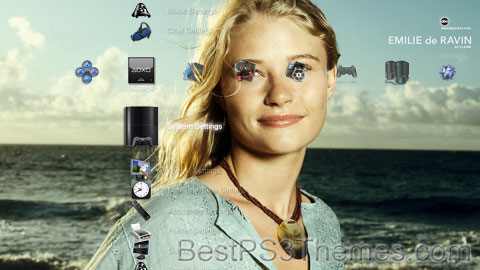
(5 backgrounds, HD only)
Redirect to:
This page is a redirect. The following categories are used to track and monitor this redirect:
|
The Undertaker Rules UPDATED
The Undertaker Rules theme by Russ Howe
Download: UndertakerRules.p3t
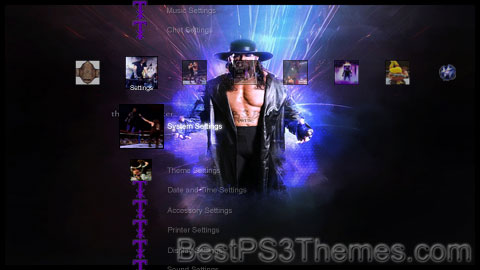
(16 backgrounds)
P3T Unpacker v0.12
Copyright (c) 2007. Anoop Menon
This program unpacks Playstation 3 Theme files (.p3t) so that you can touch-up an existing theme to your likings or use a certain wallpaper from it (as many themes have multiple). But remember, if you use content from another theme and release it, be sure to give credit!
Download for Windows: p3textractor.zip
Instructions:
Download p3textractor.zip from above. Extract the files to a folder with a program such as WinZip or WinRAR. Now there are multiple ways to extract the theme.
The first way is to simply open the p3t file with p3textractor.exe. If you don’t know how to do this, right click the p3t file and select Open With. Alternatively, open the p3t file and it will ask you to select a program to open with. Click Browse and find p3textractor.exe from where you previously extracted it to. It will open CMD and extract the theme to extracted.[filename]. After that, all you need to do for any future p3t files is open them and it will extract.
The second way is very simple. Just drag the p3t file to p3textractor.exe. It will open CMD and extract the theme to extracted.[filename].
For the third way, first put the p3t file you want to extract into the same folder as p3textractor.exe. Open CMD and browse to the folder with p3extractor.exe. Enter the following:
p3textractor filename.p3t [destination path]Replace filename with the name of the p3t file, and replace [destination path] with the name of the folder you want the files to be extracted to. A destination path is not required. By default it will extract to extracted.filename.
Odin Sphere
Odin Sphere theme by vadast
Download: OdinSphere.p3t
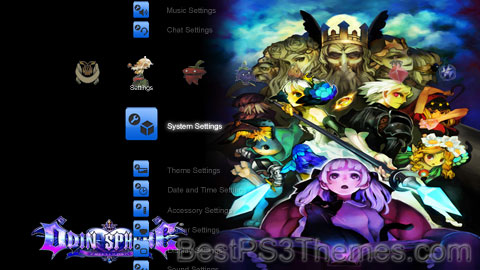
(6 backgrounds)
| Odin Sphere | |
|---|---|
 North American box art for Odin Sphere, showing the main cast and key supporting characters | |
| Developer(s) | Vanillaware |
| Publisher(s) |
|
| Director(s) |
|
| Producer(s) |
|
| Programmer(s) | Kentaro Ohnishi |
| Artist(s) | George Kamitani |
| Writer(s) | George Kamitani |
| Composer(s) |
|
| Platform(s) |
|
| Release | |
| Genre(s) | Action role-playing |
| Mode(s) | Single-player |
Odin Sphere[a] is an action role-playing game developed by Vanillaware for the PlayStation 2. It was published by Atlus (Japan and North America) in 2007, and by Square Enix (Australia and Europe) in 2008. A remake, titled Odin Sphere Leifthrasir, was released on PlayStation 3, PlayStation 4, and PlayStation Vita in 2016: Atlus handled publishing duties in Japan and North America, while NIS America published the title in PAL territories.
Using a two-dimensional side-scrolling perspective, gameplay focuses on a beat em up-style fighting system while incorporating role-playing elements — Leifthrasir expands upon and refines these elements. The story, shared between both versions, follows five characters on the fantasy continent of Erion during a war between the nations of Ragnanival and Ringford over a weapon called the Crystallization Cauldron, and their roles in the Armageddon, a catastrophe which will destroy Erion.
The game was conceived by George Kamitani as first a sequel and then a spiritual successor to the 1997 Sega Saturn title Princess Crown. Development began in 2004 after the official formation of Vanillaware. The story was based around the concept of a Valkyrie princess. The scenario and world design incorporated Norse mythology, the works of William Shakespeare, fairy tales and early video games. 2D graphics were chosen over 3D graphics as Kamitani felt the style was stagnating, which necessitated presenting cutscenes as if on a stage rather than using traditional cinematography. Leifthrasir began development in 2013 as a means of addressing the issues both players and staff had with the original game while keeping the story intact. The music for both versions was composed by a team from Basiscape, led by company founder Hitoshi Sakimoto.
Prior to Atlus picking up the title, Vanillaware had encountered difficulties finding a publisher due to Kamitani's sparse record as a developer. Completed in 2006, Odin Sphere was delayed into the following year so it would not compete with Atlus' own titles. The localization was handled by Atlus USA, and proved challenging in multiple areas. Upon release, it garnered a positive reception from video game journalists: praise was given to its story, visuals and old-school gameplay, with criticism focused on its inventory system and framerate issues. Leifthrasir was praised for its improved performance and reworked mechanics. The game was a commercial success, contributing to the rise of Vanillaware as a developer.
Gameplay[edit]
Odin Sphere is a two-dimensional (2D) side-scrolling action role-playing game where the player takes control of five different characters across six playable scenarios.[1][2] Areas within levels are circular stages allowing movement left or right with exits leading to other areas; the main goal in each area is to eliminate all enemies and proceed to the next area.[2] Combat—which uses a beat em up-style battle system—takes place within these areas, and revolves around the player character using a combination of physical attacks and Psypher skills, skills tied to each character's magical weapon. Combination attacks are triggered by attacking enemies continuously. Jumping can be used to reach airborne enemies within stages. At the end of each battle, grades are awarded based on the battle time, damage taken from enemies, and the amount of damage dealt. The amount of in-game currency the player receives as a reward after each battle depends on the battle grade.[2][3]
Rather than the typical experience point-driven character growth of most role-playing games, each characters' abilities is linked to their Psyphers, and the amount of damage characters can inflict depends upon the strength of their Psypher. These two elements are upgraded by collecting Phozons, spirit energy released from defeated enemies. Phozons fill a magic meter, which is used to trigger special skills.[2][4] All physical attacks drain a character's POW (power) gauge, and if depleted entirely the character must rest until the gauge refills.[5] Tied to Phozons and leveling is a farming system, where seeds planted and fueled with Phozons provide meals which raise a character's level, boosting their health and abilities. Food can be grown in the wild using seeds, but later two restaurants are available where prepared meals can be eaten.[2][4] Various elements, such as food and material, can be used together using an Alchemy system which allows for the creation of potions with various effects, from dealing damage to healing the main character.[3]
Leifthrasir adds to and augments the existing features. These include new battle arenas, and new vertical areas within environments to create platforming segments.[1][6] Characters now have exclusive abilities and elemental affinities, such as Gwendolyn having access to ice attacks.[1] Battle rankings now depend upon skills used and time taken rather than a quick clearing of arenas, with items as well as money being awarded for high scores.[1][6] The POW system is redesigned so that only special attacks consume POW with the exception of one character. Some special attacks also consume a portion of phozons collected in battle.[1][5] Each character also possesses skill and ability trees, which are unlocked with Phozons stored during and after battles. While skill trees are unlocked with Phozons, abilities are upgraded with Ability Points. The food and growing systems remain roughly similar, while the Alchemy system is streamlined. Leifthrasir also includes a "Classic" mode, which switches from the redesigned look of Leifthrasir to the original version.[5]
Synopsis[edit]
Setting and characters[edit]
Odin Sphere is set on the fictional continent of Erion, which is divided into multiple nations scattered across the land.[7] The two main nations are the warrior land of Ragnanival, and the forest-bound Fairy Kingdom of Ringford, separated by a wasteland that was once the kingdom of Valentine. At the game's opening, Ragnanival is ruled by the Demon Lord Odin (オーダイン, Ōdain), and Ringford is ruled by the Fairy Queen Elfaria (エルファリア, Erufaria) with help from her nephew Melvin (メルヴィン, Meruvuin). The other nations include the neutral land of Titania; the volcano-bound Fire Kingdom ruled by the one male resident King Onyx (オニキス, Onikisu); and the Netherworld, the land of the dead where natural crystals grow, ruled by the undead Queen Odette (オデット, Odetto).[7][8][9] Two key elements in the game are psyphers, weapons incorporating crystals made from phozon life energy; and the Crystallization Cauldron, a weapon created by Valentine that crafts crystals by absorbing phozons from the land.[8][9][10] A driving force of the plot is the tale of the Armageddon, a foretold catastrophe in which Erion is destroyed and the survivors rule the new world.[7][9]
Many years prior to the game's events, the world was controlled by King Valentine (バレンタイン, Barentain), who ruled the kingdom bearing his name. Originally a kind man, a spell to bring his people prosperity drained his goodness, causing him to turn into a vicious dictator who declared war on the rest of Erion. During his conquests, the Cauldron went wild and destroyed the kingdom in a single night — everyone was cursed and transformed into Pookas, while Valentine's kingdom was reduced to a wasteland.[9][11][12] In the aftermath of Valentine's fall, Ragnanival and Ringford had become Erion's most powerful nations, while the other nations have become weak in comparison.[7][8] At the game's opening, Ragnanival and Ringford are at war over possession of the Cauldron in the wasteland of Valentine, as each see the Cauldron as too dangerous for the other to possess.[9]
The story is told from the perspective of a young girl named Alice reading a series of books in her attic, with five initial storylines or "books" playing out between the five main characters and overlapping at multiple points.[7] The five main protagonists are Gwyndolyn (グウェンドリン, Guwendorin), a Valkyrie and daughter to the Demon Lord Odin who has lived for years in the shadow of her sister Griselda (グリゼルダ, Gurizeruda);[8][13] Cornelius (コルネリウス, Koruneriusu), the prince of Titania turned into a Pooka;[12][14] Mercedes (メルセデス, Merusedesu), daughter of Elfaria and later the reluctant queen of Ringford;[15] the "Shadow Knight" Oswald (オズワルド, Ozuwarudo), a dark knight in service to Ringford who was found abandoned as a baby and adopted by Melvin;[8][16] and Velvet (ベルベット, Berubetto), a survivor from the Kingdom of Valentine who hides her identity as Odin's illegitimate daughter and has been dubbed the "Forest Witch".[7][12][17] Other key characters outside the royalty of Erion's surviving nations include the Three Wise Men, a group manipulating Erion's nations to fulfill the ancient prophecies surrounding the Armageddon; Ingway (イングヴェイ, Inguvuei), Velvet's brother who like Velvet retained his humanity and was key to the disaster that consumed his kingdom; and King Valentine, having escaped the Netherworld as an insane revenant bent on destroying Erion.[8][9][12]
Plot[edit]
The game's opening sees Ringford holding the Cauldron and its controlling ring Titrel, having been given Titrel by Ingway as part of his vengeance against Odin.[18] Elfaria is ultimately killed by Odin, who takes Titrel from her.[19] Velvet steals it in turn and gives it to the dragon Wagner, hoping that this would prevent the Cauldron being used.[18] Her lover Cornelius is meanwhile changed into a Pooka by Ingway and thrown into the Netherworld, escaping with the aid of his grandfather Gallon. He learns that the people of Valentine share his curse, and is embroiled in both the Pookas' efforts to collect wish-granting coins to reverse their condition and his attempts to save Velvet from danger.[20] The Three Wise Men are attempting to fulfill the prophecies of the Armageddon — all but one Wise Man are killed during the course of the story, while the third Beldor is afflicted with the Pooka's curse and gains subsequent immortality.[19][20][21] Cornelius rescues Velvet from their clutches, and despite his fears she reaffirms her love for him in his new form.[20] Several characters also encounter King Valentine, who continues to be tormented by memories of murdering Velvet's mother in a rage — as part of his scheme to trigger the Armageddon, he hatches the dragon Leventhan.[18][19]
Gwyndolyn's story focuses on the time after her sister Griselda is killed in battle — having always come second in her father's eyes, Gwyndolyn tries hard to impress him, but must ultimately defy him when his general Brigan attempts to undermine him. Gwyndolyn is placed in an enchanted sleep for her defiance, to be woken and fall in love with the first man who kisses her.[22] After being spirited to the lands of Onyx by the Three Wise Men, Gwyndolyn's story becomes intertwined with Oswald's. Oswald is involved in an attempted coup against Mercedes by Melvin and is taken by Odette as payment for the power Melvin infused into Oswald's psypher.[21] He is then used by Odin to take Titrel from Wagner by force, but ultimately rebels and rescues Gwyndolyn from Onyx after learning that Odin did not enchant her, giving Titrel to the awoken Gwyndolyn as a gift.[21][22] Gwyndolyn, initially defiant, begins to fall in love, but is tricked into giving Titrel to Odin. Broken hearted and believing Gwyndolyn despises him due to her love being solely due to Odins spell, Oswald allows Odette to take him.[22] Mercedes' story runs parallel to the others, chronicling her efforts to become queen in the wake of her mother's death and Melvin's attempted coup, aided by Ingway after he is turned into a frog by the Three Wise Men. With the help of the dwarf smith Brom, she refashions her psypher into a weapon powerful enough to destroy Odin's psypher, winning a battle against him and taking Titrel. She also breaks Ingway's curse, and the two grow attached to each other.[19] Titrel is subsequently stolen by Gwyndolyn, who uses it as a bargaining chip to rescue Oswald from Odette, who is killed by Gwyndolyn. Initially torn between love for Oswald and duty to Odin, Gwyndolyn defies her father and leaves with Oswald and Titrel, which now acts as a symbol of their love.[22] Odin is then accosted by Ingway and Velvet; Ingway transforms into a monster in an unsuccessful attempt to kill Odin, then Velvet and Ingway are rescued by Cornelius.[18]
The sixth book shows the advent of Armageddon — King Valentine activates the Cauldron and uses it to absorb phozons from the land to feed the growth of Leventhan. Ingway attempts to destroy the Cauldron using his cursed form, but he falls under the control of Beldor, who has also led the monstrous Gallon and the Netherworld army into Erion. In the ensuing chaos, Odin is killed, and Onyx decides to destroy Ringford to avert a prophecy of his death at the "World Tree". The story then divides between the main characters' battles in the wake of these events, with different endings playing out depending on who is matched with which battle; Erion's rebirth or absolute destruction depending on whether or not the choices are correct. In the canon series of events, Cornelius defeats Ingway and Beldor and is rescued by Velvet, who learns from the dying Ingway that the Cauldron can be used to reverse the destruction; Oswald defeats Gallon, learning that he is Gallon's grandson by his banished son Edgar and thus Titanian royalty; Mercedes, whose true name is "Yggdrasil" (World Tree), finds Ingway's corpse and dies in battle after fatally wounding Onyx; Velvet stops the Cauldron without destroying its core, but King Valentine curses the Cauldron before waking Leventhan and killing himself by jumping into its path; and Gwyndolyn kills Leventhan before it can destroy Erion, losing her wings in the process.[23]
Having finished the books, Alice finds a magical coin on the front cover of the sixth book. Called downstairs by her mother, she misses seeing Cornelius and Velvet, both in Pooka form, take the coin and leave a seventh book.[23] In this book, Gwyndolyn is rescued by Oswald, who carries her to the Cauldron before collapsing. Velvet and Cornelius are there, and Velvet finds Titrel on Gwyndolyn's hand. Using Titrel, Velvet turns their psyphers back into phozons to power the Cauldron and revives the land, turning into a Pooka due to Valentine's curse. Oswald and Gwyndolyn bear witness to the rebirth of the land, and become the ancestors to the new humanity; Mercedes is reincarnated as its World Tree.[24] In a special ending set thousands of years after the events of Odin Sphere, Cornelius and Velvet have successfully gathered all the coins and use their combined power to break their curse.[25] A post-credits scene shows an unseen author, who is writing a book called "Odin Sphere", talking with a merchant while the main characters pass by.[26] A new scene in Leifthrasir shows Ingway's spirit resting within the World Tree's roots, reunited with the reincarnated Mercedes.[27]
Development[edit]
Odin Sphere was the brainchild of George Kamitani, a video game designer who had worked on Princess Crown, a 1997 Japan-exclusive side-scrolling action RPG developed by Atlus for the Sega Saturn.[28][29][30] The game was developed by Vanillaware, a studio created by former Atlus staff including Kamitani to create successor projects to Princess Crown. Initially founded as "Puraguru" in 2002 when it worked on Fantasy Earth Zero, the company changed its name in 2004 when the staff moved to Kansai.[28][31][32] It was during his time working on Fantasy Earth Zero that Kamitani met the founding members of Vanillaware.[28] Odin Sphere, which began development in 2004, was designed as a spiritual successor to Princess Crown, specifically evolving the multi-layered narrative style of the original game.[28][29] The game's programmer was Kentaro Ohnishi, one of the founding members of Vanillaware.[28][33] The producer was Atlus staff member Akiyasu Yamamoto.[34] According to Ohnishi, the project started as a direct sequel to Princess Crown, but later became a spiritual successor which incorporated multiple nods to the original game.[33] The reason it changed was that the initial plan for the Princess Crown sequel was to have used 3D visuals, which would have looked wrong with Kamitani's character designs and artwork.[35]
Development was difficult for the team due to its small size and hardware difficulties when trying to fit high-quality artwork onto the PlayStation 2 (PS2), resulting in compromises in the visual quality the team had initially planned for the project. This pressure lasted right up to release, as Ohnishi needed to do emergency work to fix game-breaking bugs.[35][36] Development was completed in 2006.[30] Vanillaware had great difficulty securing a publisher and the necessary funding for the project, as Kamitani's last project had been the unsuccessful Princess Crown over seven years before. They made unsuccessful pitches to multiple publishers before the title was finally accepted by Atlus, although there was some doubt as to whether it would prove a success.[28] While the game was completed in 2006, Atlus delayed its release into 2007 as they did not want it to cannibalize the market for their other titles, particularly Persona 3.[28][30] Odin Sphere was first revealed in February 2007, three months prior to release.[37] Odin Sphere was eventually released on May 17.[37]
Scenario and design[edit]
The initial concept for Odin Sphere was of a story revolving around a Valkyrie princess, inspired by Kamitani's wish to emulate the protagonist of Princess Crown and hearing at second hand about planning at tri-Ace for Valkyrie Profile 2: Silmeria, which involved Norse mythology and featured a princess as its main protagonist. Kamitani's Valkyrie protagonist, who would become Gwyndolin, was created before the rest of the game's world and story were finalized. Working from this initial idea and its roots in Norse mythology, Kamitani began writing a romantic storyline for Gwyndolin and Oswald as the central narrative, basing it on Der Ring des Nibelungen by Richard Wagner. He then added further elements inspired by the works of William Shakespeare and traditional European fairy tales. The other narratives focused on different themes: Mercedes' storyline focused on her maturation into a queen, Velvet's story focused on resolving a mystery, while Cornelius' story narrative modeled after traditional fairy tales as a homage to the early PC game Marchen Veil.[35] Oswald was based directly on Siegfried, the protagonist of Der Ring des Nibelungen.[38]
Odin Sphere was Kamitani's first time writing a large scenario mostly by himself. He began writing the scenario in July 2005, and while he was intended to be done by August, the writing lasted until February 2006. His original plan was something like a straight adaptation of Der Ring des Nibelungen and its associated Norse myths, but he reworked it to have more original features to incorporate more action while using its loose chronology to maintain a myth-like atmosphere.[38] As with his other projects, Kamitani included strong female characters, as he felt a woman pushed into summoning the courage to fight deserved victory.[39] There were plans to create backstory elements for characters like Odin and an extra book focusing on Ingway, but the negative impact those elements would have resulted in them being cut.[33] Originally planned to have just an hour and a half of voiced dialogue, the final total was over five hours.[40] Due to the large volume of story, dividing the narrative and dialogue into cutscenes took six months rather than the planned three.[38]
Kamitani acted as art and character designer for the game, with additional art for elements such as food provided by Takehiro "Shigatake" Shiga.[33][35] So as to distance the appearance of Gwyndolin and other Valkyries in Odin Sphere from the Valkyries of the Valkyrie Profile series, Kamitani modeled their outfits after ballet tutus. The character Mercedes was a fairy version of Gradriel De Valendia, the main protagonist of Princess Crown. Velvet's design was described as an "Arabic Little Red Riding Hood". More sensual elements of his female character designs came about through chance rather than deliberate design.[35] A few monster designs were recycled from Princess Crown. The artwork was created at full scale, then shrunk down to fit within the PS2 hardware specifications.[38]
Despite the general move to 3D graphics in the gaming industry, the team decided to use 2D graphics, as Kamitani felt the style was stagnating.[35][41] The use of 2D graphics meant that traditional cinematographic camera work for cutscenes was impossible to achieve, so the team instead modeled them after scenes from a stage production.[35] This style was also chosen due to the story's Shakespearean atmosphere.[39] The character graphics were hand-drawn in a process Kamitani dubbed "tebineri", or hand-shaping. The toolset used to create the graphic animations was heavily inspired by the similar animation style used for Adobe Flash products.[30] An element that proved troublesome was character movement, which was hard to make behave within the limited hardware specifications of the PS2. A cited example was how Velvet's breasts jiggle slightly when she stops moving. This was intended for more female characters, but due to the hardware limitations it was restricted to Velvet.[36]
Localization[edit]
The game was localized for the West by Atlus USA. The project leader was Bill Alexander, the lead translator was Sammy Matsushima, while dialogue editing was handled by Mike Meeker. As with their other localizations such as for the Persona series, the team tried to stay faithful to the original text. This proved easier than for the Persona series as its fictional setting meant there were no cultural in-jokes that would not be understood outside Japan.[42] The localization took place from 2006 to 2007: the project was an unusual one for Atlus, as it was an entirely new intellectual property from a studio that was still little known in the West.[43] When tasked with localizing the game for Western markets, the team were told that the game had a Shakespearean feel, so Matsushima created a script that reflected that: with the concept of a play in mind, the dialogue was written to give a noble feel to the characters, in addition to fairy tale elements fitting in with its frame story of a girl reading books. For his part, Meeker read King Lear and A Midsummer Night's Dream to find the correct style for his writing, in addition to reading Beowulf to properly capture the narrative's darker elements.[42]
The localization proved more challenging than other Atlus projects for multiple reasons. As the characters' text bubbles were designed to use Japanese kanji characters—which compress a lot of information into a single symbol in a way impossible in the English alphabet—each text bubble had to be individually resized and sometimes shifted so they would not intrude on other elements within scenes.[42] The sheer amount of voice acting in the game meant that dubbing took far longer than other similar projects, running past its projected time and requiring Atlus staff members to voice very minor characters to save time.[43] The main characters were a major focus due to the storytelling style of multiple interlinked narratives, with each character's personal growth needing to be reflected in their voice performance. This was particularly true of Mercedes.[42] The auto-scrolling nature of dialogue, which moved along at a set pace rather than through the player's button prompts, meant that performances needed to be correctly timed and balanced to the varying paces at which the actors read their lines. This led to lines being modified during recording to keep within schedule. During the last stages, the team needed to rerecord some lines of dialogue, but to keep the localization in budget and on schedule it was done outside a professional recording studio, resulting in an audible drop in quality.[42][43]
Odin Sphere was released in North America on May 22, 2007, less than a week after the game's Japanese release.[44] In Europe, it was released on March 14, 2008, by Square Enix.[45] Available with in-game text in English, French, German, Spanish and Italian, it was the first non-Square Enix title the company released in Europe.[46] The European version also included technical improvements that allowed the game to run better than the North American version.[47] It was also published in Australia on March 13.[48] The Japanese voice track was included in the game as a special extra feature for fans of anime. The localization process was timed so that the Japanese and North American releases were days apart rather than months, which put extra pressure due to some promotional assets still being in development in Japan.[42]
Odin Sphere Leifthrasir[edit]
Odin Sphere Leifthrasir,[b] a remake of Odin Sphere for PlayStation 3, PlayStation 4 and PlayStation Vita, began development in late 2013 alongside publisher Atlus changing ownership from Index Corporation to Sega.[50] Ohnishi acted as the remake's director, while Kamitani produced.[33][36][39] Atlus initially wanted to create a followup to Vanillaware's recent successful title Dragon's Crown, but when Odin Sphere came up in conversations, it was decided to work on that as it was both Vanillaware's first p
Lakes
Lakes theme by tony
Download: Lakes.p3t
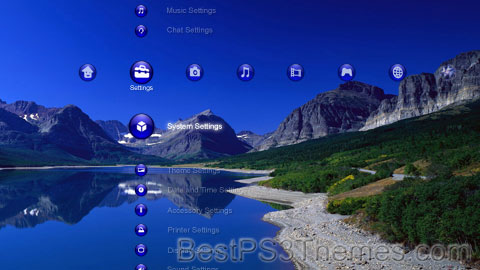
(8 backgrounds)
Redirect to:
This page is a redirect. The following categories are used to track and monitor this redirect:
|
Phototropic V2
Phototropic theme by yogosan
Download: Phototropic.p3t
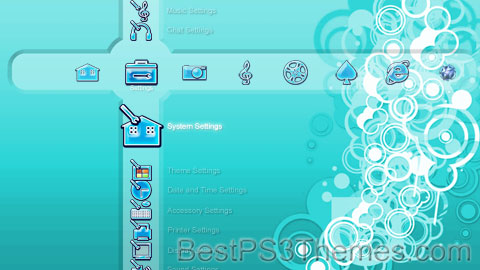
(4 backgrounds)
P3T Unpacker v0.12
Copyright (c) 2007. Anoop Menon
This program unpacks Playstation 3 Theme files (.p3t) so that you can touch-up an existing theme to your likings or use a certain wallpaper from it (as many themes have multiple). But remember, if you use content from another theme and release it, be sure to give credit!
Download for Windows: p3textractor.zip
Instructions:
Download p3textractor.zip from above. Extract the files to a folder with a program such as WinZip or WinRAR. Now there are multiple ways to extract the theme.
The first way is to simply open the p3t file with p3textractor.exe. If you don’t know how to do this, right click the p3t file and select Open With. Alternatively, open the p3t file and it will ask you to select a program to open with. Click Browse and find p3textractor.exe from where you previously extracted it to. It will open CMD and extract the theme to extracted.[filename]. After that, all you need to do for any future p3t files is open them and it will extract.
The second way is very simple. Just drag the p3t file to p3textractor.exe. It will open CMD and extract the theme to extracted.[filename].
For the third way, first put the p3t file you want to extract into the same folder as p3textractor.exe. Open CMD and browse to the folder with p3extractor.exe. Enter the following:
p3textractor filename.p3t [destination path]Replace filename with the name of the p3t file, and replace [destination path] with the name of the folder you want the files to be extracted to. A destination path is not required. By default it will extract to extracted.filename.
Elfen Lied #2
Elfen Lied theme by tony
Download: ElfenLied_2.p3t
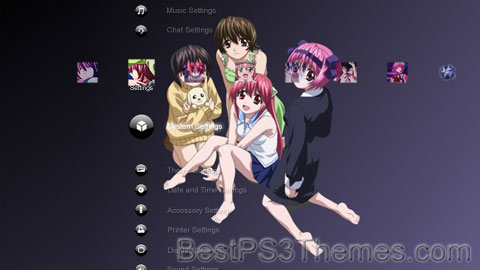
(7 backgrounds)
| Elfen Lied | |
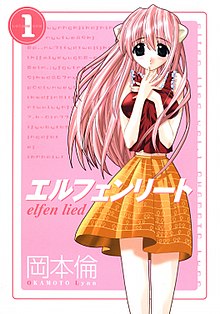 First tankōbon volume cover, featuring Nyu | |
| エルフェンリート (Erufen Rīto) | |
|---|---|
| Genre | |
| Manga | |
| Written by | Lynn Okamoto |
| Published by | Shueisha |
| English publisher | |
| Imprint | Young Jump Comics |
| Magazine | Weekly Young Jump |
| Demographic | Seinen |
| Original run | June 6, 2002 – August 25, 2005 |
| Volumes | 12 |
| Anime television series | |
| Directed by | Mamoru Kanbe |
| Produced by |
|
| Written by | Takao Yoshioka |
| Music by |
|
| Studio | |
| Licensed by |
|
| Original network | AT-X |
| English network | |
| Original run | July 25, 2004 – October 17, 2004 |
| Episodes | 13 + OVA |
Elfen Lied (Japanese: エルフェンリート, Hepburn: Erufen Rīto) is a Japanese manga series written and illustrated by Lynn Okamoto. It was serialized in Shueisha's seinen manga magazine Weekly Young Jump from June 2002 to August 2005, with its 107 chapters collected into twelve tankōbon volumes. Elfen Lied revolves around the interactions, views, emotions, and differences between human beings and the Diclonii, a mutant species similar to humans in build but distinguishable by two horns on their heads and "vectors", transparent telekinetically controlled arms that have the power to manipulate and cut objects within their reach. The series is centered on the teenage Diclonius girl "Lucy" who was rejected by human beings and subsequently wants revenge.
The series takes its name from the song "Elfenlied", German for "song of the fairies", which is featured in the story. Elfen Lied involves themes of discrimination, social alienation, identity, prejudice, revenge, abuse, jealousy, regret, and the value of humanity. It is also noted for the graphic violence, emotional themes of how the characters change through, and the overall transgressive subject matter of the whole story.
A 13-episode anime television series adaptation was produced by the studio Arms and broadcast on AT-X from July to October 2004. The anime finished airing before the manga was complete; as a result, the plot differed between the two, especially the ending. The manga is licensed in North America by Dark Horse Comics. The anime series has been licensed in North America by ADV Films and in Australia by Madman Entertainment.
Plot and characters[edit]
Elfen Lied takes place in Kamakura and Kanagawa, and focuses on the "Diclonius", a newly mutated species. Their appearance is similar to humans, but with several differences, namely horn-like protrusions on the forehead, the presence of telekinetic invisible arms called "vectors" and unconventional hair colour. One such Diclonius, Lucy, is the main character of the series: Initially held in a facility built for experimentation, located off the coast of Kamakura, she manages to escape and wreak havoc, but is injured in the process, an event which causes her to develop a secondary, childlike personality known as Nyu.
Lucy is found by two locals, Kouta and his cousin Yuka, who study at the local university. They take her in and become involved with the numerous, often brutal, attempts to recapture her by a Special Assault Team and a number of other Diclonius, who shift frequently from oblivious to murderous.
Diclonius[edit]
Much of the plot of Elfen Lied revolves around the Diclonii species, which strongly resemble humans; the only obvious difference is the two horn-like protrusions extending from the temporal bone and parietal bone regions of the skull.
Diclonii powers involve the use of invisible arms, known as "vectors", that can grasp and impact things as if they are solid, but also become insubstantial and pass through objects. They can slice objects as well, which is how Diclonii usually kill their victims. Vectors usually have a limited range of a few meters, but the length varies among each Diclonius. Diclonii also demonstrate the ability to sense one another.
A key point of debate throughout the series is the Diclonius propensity towards violence. Many have a vendetta against humans, and have ambitions to wipe out the human race and populate the world with their own species. It is disputed and contradicted during the series as to how Diclonii develop their violent behavior, whether it is part of their genetic code or whether it stems from abuse by humans.
If a Diclonius vector penetrates or even so much as touches a human male body, the "vector virus" is transferred to the human, causing their children to be born as Diclonii (when born from infected humans, they are called "Silpelits"). An incident involving the escape of a child Diclonius during Kurama's early years, where the Diclonius' vectors penetrated him without causing him pain, resulted in Mariko being born a Diclonius and Kurama taking precautions against a recurrence by urging Bando to be sterilized.[6] All Silpelits are sterile, female and age rapidly. There's only one Diclonius that is actually capable of reproducing: Lucy, the "queen".
Production[edit]
Anime[edit]
When Elfen Lied was being adapted into an anime series, director Mamoru Kanbe was recommended to work on the series by the series composer, Takao Yoshioka. Yoshioka believed that Kanbe's general drawing style and composition would be ideal to adapt the manga, still in publication at the time, into an anime series. Kanbe himself, originally reluctant about joining the production, gained interest in it upon reading the manga.
While the manga was still ongoing at the time, Kanbe and the production team were forced to condense the plot of the series into thirteen episodes, even though they felt it was necessary to make more as several significant plot details in the manga which Kanbe felt he could have used to make the series more emotive were left out.[7]
According to Kanbe, he considered Elfen Lied as a "love story," and he wanted to "bring viewers to tears."[7] Thus, he made attempts throughout the series to provide a contrast of emotions, commenting that he could make the violence exemplify this throughout the series. The production team were originally surprised by Okamoto's choice of Kamakura as a setting for the series; however, after several visits to the area, Kanbe commented that the setting in Kamakura was, according to the production team, ideal for the poignant and reflective drama in the series to unfold, as its general tranquility and geography made for a reflective and yet eerie, deep-meaning backdrop to the series.[8] This can be seen in several examples, such as on top of a set of steps overlooking the coastline, where many of the interactions between characters take place. This is used as an important device in conveying the ideas of memory and emotional association, such as the contrast between Kohta and Lucy's conversation when they were ten years old in comparison with their conversation in the final episode.
Style and themes[edit]

In comments made by director Mamoru Kanbe on the Elfen Lied website, he stated that he intended for the anime to question and discuss values relating to the way in which humans divide each other by difference, as well as the belief that atrocities such as those committed by Lucy in the series are strongly influenced by the way in which people are treated by their fellow beings. The series frequently discusses the events and treatment which define the human character in such a way, and the problems which arise from discrimination, as well as the wild contrasts between compassion and vengeance between fellow humans, through the strong vengeance of Lucy compared with her past memory of Kohta. Many of the themes are mentioned at the teasers at the ends of episodes.
Themes such as genocide and the attempts to "purify" the earth from each other also appear in the anime. Both Diclonius and the human species feel the need to populate the earth with their own and wipe the other out. Kanbe quoted this in relation to the desire of humans to cast each other out and segregate one another.[9]
Throughout the series, there is a great deal of blood and gore, graphic violence as well as psychological violence. One of the most prevalent motifs of the series is the humanity of the Diclonius, especially contrasted against the inhumanity of ordinary people. One reviewer described the series as "devoted to quite a few of the darker, more callous factors of human nature."[10] Throughout the series there are various incidences of casual beatings, cruel experimentation, and outright killing. Also, animal cruelty is present when three young boys mercilessly beat Lucy's puppy until it dies; though the act is off-screen, a copious amount of blood is shown; which drives Lucy to murder the bullies out of revenge and insanity.

Most of the episodes contain graphic violence, including instances of torture and at one point the series addresses consequences of the rape of a child. The series also includes scenes that present female nudity and strong language (specifically in the English dub). The series juxtaposes many different tones and genres and was described by Bamboo Dong of Anime News Network as "mixing insane amounts of violence with a heavy dose of ultracuteness."[11] The series balances its darker themes with romantic sub-plots as well as many comic moments. Elfen Lied has been described as similar to, or borrowing elements from Chobits, 3x3 Eyes[12] and Gunslinger Girl.[11]
Cultural references[edit]
The opening and ending sequences feature artistic drawings of the principal characters. These characters are drawn in a style based on Gustav Klimt's paintings, including The Kiss, Adele Bloch-Bauer I, and others with similar imitating poses, colors, and patterns.[12] In promotional art as well as in the series itself, characters make use of a famous El Greco hand symbol of outstretched fingers with the middle and ring fingers connected. The song Elfenlied ("Elf Song") appears in the manga[13] and is credited to the composer Hugo Wolf. A poem by Eduard Mörike is the basis for Wolf's version. It is taught to Nyu by the manga-only protagonist Nozomi. In the manga, the Diclonius are kept in a grotto called the Lebensborn Cave, a reference to the Nazi eugenics program.[14]
Media[edit]
Manga[edit]
Written and illustrated by Lynn Okamoto, Elfen Lied was serialized in Shueisha's seinen manga magazine Weekly Young Jump from June 6, 2002, to August 25, 2005.[c] Shueisha collected its 107 chapters in twelve tankōbon volumes, released from October 18, 2002,[18] to November 18, 2005.[19]
In North America, the manga was licensed for English release by Dark Horse Comics.[20] They released it in a four-volume omnibus edition from May 22, 2019,[21] to September 9, 2020.[22]
Anime[edit]
A 13-episode anime television series adaptation was directed by Mamoru Kanbe, animated by Arms and produced by Genco and VAP. Author Lynn Okamoto has a brief cameo appearance in episode 12. Elfen Lied first aired on TV Tokyo's AT-X satellite channel from July 25 to October 17, 2004, and was broadcast again in 2005. A single twenty-four-minute original video animation (OVA) episode was released by VAP on April 21, 2005. It takes place somewhere within the timespan of the series' eleventh episode.
The anime's opening theme song is "Lilium", performed by opera singer Kumiko Noma, sung in Latin, with lyrics extracted from biblical passages and Christian sources, including the Book of Psalms, the Epistle of James, the Kyrie prayer, and the hymn "Ave mundi spes Maria".[23][24][25][26] The ending theme song is "Be Your Girl" by Chieko Kawabe.
- Home media and distribution
The series was released on Blu-ray in Japan on December 19, 2012.[27]
The anime was licensed by ADV Films in the United States in 2004 and released on DVD in 2005. ADV said the series was one of their bestselling and "most notorious" releases of 2005.[28][29] During the Anime Boston 2006[30] convention, ADV announced the distribution rights of the OVA in the United States. However, the OVA was never released on television and was not included with the box set released by ADV Films in November 2006 or in the "Complete Collection" DVDs released in June 2009 and December 2011. When ADV divided their assets, Elfen Lied was remained with them and in-print. A Blu-ray box set (as well as a new DVD set) was released on September 3, 2013, by ADV and Section23 Films, making it the only Blu-ray release under the ADV brand, and contains the previously released OVA.[31][32] In Australia, the series was licensed by Madman Entertainment.[33]
The series aired in the United Kingdom on Propeller TV (Sky) as part of Anime Network's short-lived launch in the United Kingdom. The series also aired uncut despite a stricter censorship standard imposed by OFCOM on UK cable TV. The Anime Network is streaming the series On Demand in English, German and French.[4] The ADV DVD box set confirms a rating of TV-MA SV; the Canadian rating is 14A.
In a post to the now defunct official Adult Swim message board in April 2006, programming director Kim Manning revealed that despite the series' high level of controversial content, the network inquired into the possibility of airing, as Manning was an avid fan herself and watched the entire series in one sitting. However, the channel's Broadcast Standards and Practices department would have required the series to be so extensively edited ("it would have been cut to shreds", she described in the post) in order to air that it would have been "unintelligible". Ultimately, Adult Swim decided not to air it to preserve and respect the series' original quality.[34]
Reception[edit]
Reviewing the first English omnibus volume of Elfen Lied, Anime UK News gave it an 8 out of 10 rating and noted that it is much more detailed than the anime adaptation by explaining what Diclonius are and showing more of the characters' inner thoughts. Although, they stated that the beginning of the anime had "more punch." Anime UK News criticized Okamoto's art as poor throughout the book, but enjoyed the extra unrelated stories included at the end.[35] Comic Buzz gave a 9/10 score, calling it a "great read from start to finish". They felt the art style changed with the characters' emotions and said it reminded them variously of Neon Genesis Evangelion and the work of Junji Ito.[36] Rai of TheOASG gave the omnibus a 3 out of 5 star rating, criticizing the art and fan service, and overall preferred the anime which she acknowledged having bias for.[37]
Reception for the anime was generally mixed to positive. Reviewers such as Tasha Robinson of Sci Fi Weekly and Theron Martin of Anime News Network praised Elfen Lied for its story and technical excellence in production quality, animation and color.[12][3][38][39] Due to the many scenes of nudity and gore, Dominic Laeno of THEM Anime Reviews criticized the series as being "overly blatant."[40] Martin criticized the anime for having "sub-par voice acting" in both the original Japanese audio track and the English dub, although he gave an "A−" rating for both language dubs.[3] Martin also said that the series "ends abruptly with some loose ends to the story that could leave viewers unsatisfied," but also called it "a horror series of exceptional merit."[41] Laeno called the series "a genuinely good watch."[40] Stig Høgset, also of THEM Anime Reviews, called Elfen Lied "a very special show, good and bad parts taken into consideration."[10]
On June 12, 2015, the now-defunct Chinese Ministry of Culture listed Elfen Lied among 38 anime and manga titles banned in China.[42]
Legacy[edit]
Matt and Ross Duffer have cited Elfen Lied as an influence on their 2016 Netflix series Stranger Things. They said that Elfen Lied was like an "ultraviolent E.T." and noted that the character Eleven was inspired by the anime. Another cited influence was the 1988 anime film Akira, which they felt had in turn influenced Elfen Lied.[43]
The anime opening theme "Lilium", with its Latin lyrics extracted from biblical sources, is sometimes sung as a hymn in churches around the world, including in countries such as Ukraine, Sweden, Brazil, and Chile.[44][45]
Notes[edit]
- ^ Production studio and main animation studio for episodes 1, 3, 4, 6, 8, 9, 10.5 (OVA), 11 and 13.
- ^ Main animation studio for episodes 2, 5, 7, 10 and 12.
- ^ It was serialized in the magazine from the 27th issue of 2002 to the 39th issue of 2005,[15] released on June 6, 2002,[16] and August 25, 2005, respectively.[17]
References[edit]
- ^ ダークファンタジーまとめ. Akiba Souken (in Japanese). Kakaku.com. March 20, 2019. Archived from the original on April 12, 2021. Retrieved January 5, 2020.
- ^ "Anime UK News – Our Favourite Halloween Specials". Anime UK News. October 29, 2018. Archived from the original on October 6, 2023. Retrieved December 10, 2019.
Elfen Lied is a dark fantasy series that will rip your heart out both emotionally, and literally.
- ^ a b c Martin, Theron (May 16, 2005). "Elfen Lied DVD 1 - Review". Anime News Network. Archived from the original on August 12, 2019. Retrieved August 8, 2019.
- ^ a b SOber (November 22, 2013). "Elfen Lied (German and French) Now Available!". Anime Network. Archived from the original on August 24, 2015. Retrieved August 8, 2019.
- ^ "Elfen Lied South Africa Animax". Animax. July 25, 2004. Archived from the original on July 27, 2009. Retrieved February 23, 2015.
- ^ "Deep Feelings ~ Im Innersten". Elfen Lied. Season 1. Episode 3. August 8, 2004. AT-X.
- ^ a b Exclusive Mamoru Kanbe interview, DVD Extra – Elfen Lied DVD 1 (Vector One). Released by Madman Entertainment and ADV Films.
- ^ "Production Note". Elfen Lied (in Japanese). VAP. Archived from the original on January 23, 2019. Retrieved March 20, 2008.
- ^ "Backstage – Official Elfen Lied website" (in Japanese). Archived from the original on November 1, 2013. Retrieved December 1, 2007.
- ^ a b<
Team Fortress 2 #3
Team Fortress 2 theme by Cameron
Download: TeamFortress2_3.p3t
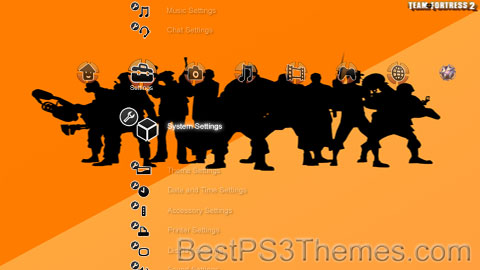
(3 backgrounds)
| Team Fortress 2 | |
|---|---|
 Promotional art depicting the nine playable classes | |
| Developer(s) | Valve |
| Publisher(s) | Valve |
| Designer(s) |
|
| Composer(s) | Mike Morasky |
| Engine | Source |
| Platform(s) | |
| Release | October 10, 2007
|
| Genre(s) | First-person shooter |
| Mode(s) | Single-player, multiplayer |
Team Fortress 2 (TF2) is a 2007 multiplayer first-person shooter game developed and published by Valve Corporation. It is the sequel to the 1996 Team Fortress mod for Quake and its 1999 remake, Team Fortress Classic. The game was released in October 2007 as part of The Orange Box for Microsoft Windows and the Xbox 360, and ported to the PlayStation 3 in December 2007.[2][3] It was released as a standalone game for Windows in April 2008, and updated to support macOS in June 2010 and Linux in February 2013. It is distributed online through Valve's digital retailer Steam, with Electronic Arts managing retail and console editions.
Players join one of two teams—RED (Reliable Excavation Demolition) and BLU (Builders League United)—and choose one of nine character classes to play as, with game modes including capture the flag and king of the hill. Development was led by John Cook and Robin Walker, the developers of the original Team Fortress mod. Team Fortress 2 was announced in 1998 under the name Team Fortress 2: Brotherhood of Arms. Initially, the game had more realistic, militaristic visuals and gameplay, but this changed over the protracted nine years of development. After Valve released no information for six years, Team Fortress 2 regularly featured in Wired News's annual vaporware list among other entries. Finally released on the Source game engine in 2007, Team Fortress 2 preserved much of the core class-based gameplay of its predecessors while featuring an overhauled, cartoon-like visual style influenced by the works of J. C. Leyendecker, Dean Cornwell, and Norman Rockwell, alongside an increased focus on the visual and verbal characterization of its playable classes and what the developers have described as a 1960s spy movie aesthetic.
Team Fortress 2 has received critical acclaim for its art direction, gameplay, humor, and use of character in a wholly multiplayer game,[4][5][6][7] and since its release has been referred to as one of the greatest video games ever created.[8][9][10] The game continues to receive official Valve server support as of January 2024,[11] in addition to new content being released on a seasonal basis in the form of submissions made through the Steam Workshop. In June 2011, the game became free-to-play, with revenue derived from microtransactions for in-game cosmetics. A 'drop system' was also added and refined, allowing free-to-play users to periodically receive in-game equipment and items. Though the game has had an unofficial competitive scene since its release, both support for official competitive play through ranked matchmaking and an overhauled casual experience were added in July 2016.[12] Since early 2020, the official Valve servers have seen an influx of bot accounts using cheat software, often inhibiting legitimate gameplay, which led to multiple online protests to call for actions against the bots and their hosts.[13]
Gameplay[edit]

In most game modes, two teams, RED and BLU, compete for a combat-based objective.[5] Players can choose to play as one of nine character classes in these teams, each with their own unique strengths, weaknesses, and weapon sets. In order to accomplish objectives efficiently, a balance of these classes is required due to how these strengths and weaknesses interact with each other in a team-based environment. Although the abilities of a number of classes have changed from earlier Team Fortress incarnations, the basic elements of each class have remained, them being one primary weapon, one secondary weapon, and one melee weapon.[14][15] The game was released with six official maps, although over one hundred maps have since been included in subsequent updates, including community-created maps.[16][17] When players choose a gamemode for the first time, an introductory video is played, showing how to complete its objectives. During matches, the Administrator,[18] voiced by Ellen McLain, announces the teams' current objectives over loudspeakers.[19] The player limit for one match is 16 on the Xbox 360 and PlayStation 3, and 24 on the Windows edition.[20] However, in 2008, the Windows edition was updated to include a server variable that allows for up to 32 players.[21] Furthermore, in 2023, the Windows edition was updated to have unrestricted player counts for up to 100 players in a single server.[22]
Team Fortress 2 is the first of Valve's multiplayer games to provide detailed statistics for individual players, such as the total amount of time spent playing as each class, most points obtained, and most objectives completed in a single life. Persistent statistics tell the player how they are performing in relation to these statistics, such as if a player comes close to their record for the damage inflicted in a round.[16] Team Fortress 2 also features numerous achievements for carrying out certain tasks, such as achieving a certain number of kills or completing a specific objective. Sets of class-specific achievements have been added in updates, which can award weapons to the player upon completion. This unlockable system has since been expanded into a random drop system, with which players can also obtain items simply by playing the game.[23]
Game modes[edit]
Core game modes[edit]
Team Fortress 2 contains five core game modes.
- Attack/Defend (A/D) is a timed game mode in which the BLU team's goal is to capture RED's control points. The number of control points varies between maps, and the points must be captured by the BLU team, usually in sequence. To capture a control point, a player must stand on it for a certain amount of time, with more players increasing the speed it is being captured at. RED, who cannot capture points, must prevent BLU from capturing all the control points before the time-limit expires. Once a point is captured, the time-limit will be extended by several minutes.[24]
- Capture the Flag (CTF) is a mode in which RED and BLU must steal the opposing team's flag (an intelligence briefcase) and prevent their own intelligence from being stolen. When the intelligence is dropped by the carrier, it will stay on the ground for 1 minute before returning to its original location if it is not picked up again. A team's intelligence can be carried only by the opposing team. The first team to capture the enemy's intelligence three times wins.[25]
- Control Points (CP) is a timed game mode where there are several control points placed around the map, with three (3CP) or five (5CP) control points in total depending on the map. The game will start off with only the middle control point being available for capture, with the other control points split equally among both teams. Once this middle control point is captured, a team can begin capturing the enemy team's points in respective order. The time limit is extended on the capture of a control point by either team. For a team to win, they must capture all the control points within the time limit.[24]
- King of the Hill (KOTH) is a timed game mode that contains a single control point at the middle of the map that can be captured by both RED and BLU. Should the opposing team capture the point from the team that had it before, their timer will stop and the opposing team's timer will begin or resume. The point can be recaptured by each team as many times as is possible. The first team to control the point for 180 seconds (not necessarily continuous) wins.[26]
- Payload (PL) is a timed game mode where BLU must push an explosive cart along a track, while RED must prevent the cart from reaching their base. To push the cart, at least one BLU player must be in range of the cart, with more players increasing the push speed. Maps have multiple 'checkpoints' along the track; each checkpoint reached by the cart awards the BLU team with additional time. If the cart is not pushed by BLU for some time, it will begin to roll back to the last achieved checkpoint. RED players can obstruct the cart from being pushed by being within range of it.[27]
Alternative game modes[edit]
There are several alternative game modes in Team Fortress 2. These modes consist of a small number of maps and detach from the core game modes in some way.
- Arena is a special game mode in which players do not respawn upon death. A team can win either by eliminating all opposing players, or by claiming a single capture point that opens after a certain time has elapsed.[28] This mode is currently unavailable through matchmaking, but is still accessible through community servers.
- Mannpower is a mode in which players have access to a grappling hook and assorted power-ups laid around the map that grant unique abilities.[29] While not bound to any specific mode, all current official Mannpower maps use a variation of Capture the Flag. In Mannpower's variation of Capture the Flag, both teams have an intelligence flag, and the first team to capture the enemy's intelligence ten times wins. The mode is based on the Quake mod 'Threewave CTF' created by former Valve employee David Kirsch.[30]
- Medieval Mode is a mode in which players are restricted to using melee and support weapons, with certain exceptions for medieval-themed projectile weapons.[31] While not bound to any specific mode, the only official Medieval Mode map uses a 3CP variation of Attack/Defend. If Medieval Mode is enabled on a map, select phrases spoken by players in the in-game text chat will be replaced with more thematic variants, such as "hello" being replaced with "well meteth".
- PASS Time is a unique timed game mode inspired by rugby, developed by Valve, Bad Robot Interactive, and Escalation Studios.[32] Three unique goals (the Run-In, Throw-In, and Bonus Goals) are placed on each team's side of the map. A single ball called the JACK will spawn at the center of the map, and players must pick it up and carry it to the opposing team's side. While holding the JACK, players cannot fire their weapons, but passive effects are still applied. Players can score a goal by either carrying the JACK to a Run-In Goal or by throwing the JACK through the Throw-In Goal. Three goals can be scored by throwing the JACK through the Bonus Goal, which is much more difficult to score. To win, a team must either score five goals, or have the most goals when the timer runs out.
- Payload Race is similar to Payload, but both the RED and BLU teams have a cart that they must push, while preventing the opposing team from doing the same. There are multiple checkpoints along the track, and there is no time limit. The team to reach the end of their track first wins a point. The game lasts until one team gets two points.[33]
- Player Destruction is a community-made game mode in which a player's death causes a pickup to appear. The first team to collect a set number of pickups and deliver them to a drop-off point wins the game. The players on each team with the most pickups are highlighted for everyone to see, and gain a passive healing effect for themselves and any nearby teammates.
- Special Delivery is a mode similar to Capture the Flag, but there is only one neutral briefcase that can be picked up both the RED and BLU teams. Upon a team picking up the briefcase, the opposing team will be unable to pick up the briefcase until it has been dropped for 45 seconds and respawns as a neutral briefcase. A team wins by carrying the briefcase onto a loading platform, which will gradually rise until the platform reaches its peak.[34]
- Territorial Control consists of several control points spread out across a single map. Like Control Points, each point can be captured by either the RED or BLU teams. Unlike Control Points, only two points are accessible at a single time. Upon a team's successful capture of a point, the "stage" ends and the accessible capture points change. When a team only has control of a single control point, they are blocked from capturing the opposing team's control point and the team must wait until the time limit is up and the accessible capture points change. A team wins by capturing all the control points.[24]
- Versus Saxton Hale is a juggernaut game mode that originated as a mod for the Arena mode developed by LizardOfOz, which was then popularized on community servers. It pits one player as Saxton Hale (on BLU) against all other players (on RED). Saxton Hale is restricted to melee attacks, but he can perform a double jump, a charge attack that allows him to fly in any direction, a body slam that creates a damaging shockwave upon landing, and a super punch, which deals more damage than a regular punch. Like in Arena, Saxton or RED can win by eliminating the opposing player(s), or by capturing a single control point after enough time elapses.[35][36]
Other game modes[edit]
These modes are not categorized with the other modes, and instead have their own separate sections in the game.
- Halloween Mode is a special mode that is enabled during Halloween, and allows the players access to more than 20 Halloween themed maps, Halloween-exclusive cosmetics and challenges. For example, Halloween 2012 included a difficult Mann vs. Machine mission involving destroying more than 800 enemy forces.[37] Owing to popular demand of the Halloween events, Valve later added the Full Moon event, an event that triggers around every full moon phase throughout the year, which allows players to equip Halloween-exclusive cosmetics. In 2013, Valve introduced an item called Eternaween, and upon use, allows players of a specific server to use Halloween-exclusive cosmetics for 2 hours.[38]
- Mann vs Machine (MvM) is a cooperative game mode where players must defend their base from waves of robots modeled after all nine playable classes, and in some maps, slow-moving tanks carrying bombs. Robots and tanks drop a currency referred to as Credits upon their death, which players can use to buy upgrades for themselves or their weapons. The players win upon successfully defending their base from the bomb until the last wave.[39] A paid version of this game mode called "Mann Up" is also available, where players buy "Tour Of Duty Tickets" to play a series of missions with the chance to win unique cosmetics, weapons and robot parts that can be used in crafting.[40]
- Offline Practice Mode consists of the player and computer-controlled bots. The number of bots, their difficulty, and the map can all be adjusted to a player's preference, though only a select amount of maps are available to play.[41][42][43]
- Training Mode exists to help new players get acquainted with basic controls, and teaches them the basics of four of the nine classes. It uses wooden dummies and bots to teach players the basic mechanics of classes and the game.[41]
Competitive play[edit]
Team Fortress 2 is played competitively, through multiple leagues. The North American league, ESEA, supports a paid Team Fortress 2 league, with $42,000 in prizes for the top teams in 2017.[44][45][46] While formalized competitive gameplay is very different from normal Team Fortress 2, it offers an environment with a much higher level of teamwork than in public servers. Most teams use voice chat to communicate, and use a combination of strategy, communication, and mechanical skill to win against other teams. Community-run competitive leagues also tend to feature restrictions such as item bans and class limits. These leagues are often supported by Valve via in-game medals (which are submitted via the Steam Workshop) and announcements on the official blog.[47][48][49]
In April 2015, Valve announced that a dedicated competitive mode would be added to Team Fortress 2, utilizing skill-based matchmaking;[50] closed beta testing began in the following year.[51] The competitive mode was added in the "Meet Your Match" update, released on July 7, 2016.[52] Ranked matches are played six-vs-six, with players ranked in thirteen tiers based on win/losses and an assessment of their skills.[53] Ranked matchmaking will balance players based on their tiers and rating. A similar matchmaking approach has been added for casual games for matches of 12-vs-12 players. In order to join competitive matchmaking, players must have associated their Steam account with the Steam Guard Mobile Authenticator, as well as having a Team Fortress 2 "premium account", which is unlocked by either having bought the game before it went free-to-play or by having made an in-game item purchase since.[54]
Formats[edit]
Team Fortress 2 is played in a variety of different formats, which dictate the maximum size and composition of a team and can drastically change the impact of a single player's gameplay or choice of class. The two most basic formats consist of 12v12 and 6v6 ("Sixes"), the two being used on official Valve servers for casual and competitive modes respectively with no additional limitations. Most competitive leagues host Sixes but include limits on certain classes and weapons to preserve traditional, skill-based playstyles, for example limiting the allowed amount of Medics or Demomen to one on either team or banning certain movement-enhancing weapons from use. Other popular formats include "Highlander", a 9v9 format with a limit of one player per each of the nine classes, as well as a Sixes-inspired 7v7 variant thereof known as "Prolander" to allow for strategically switching classes during a competitive game.[47][48][55]
Characters and setting[edit]
This section needs additional citations for verification. (July 2022) |
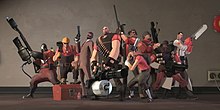
Team Fortress 2 features nine playable classes, which are evenly split and categorized into "Offense", "Defense", and "Support".[16] Each class has strengths and weaknesses and must work with other classes to be efficient, encouraging strategy and teamwork.[56] Each class has at least three default weapons: a primary weapon, secondary weapon, and melee weapon. Engineers have two additional slots for their PDAs, and Spies have an additional slot for their disguise kit. An additional character, Saxton Hale, is playable in the "Versus Saxton Hale" game mode.[57]
Offense[edit]
- The Scout (voiced by Nathan Vetterlein) is an American baseball fan and street runner from Boston, Massachusetts who practiced running to be faster than his seven siblings.[58] He is a fast, agile character, who is armed by default with a scattergun, a pistol, and a bat. The Scout can double jump, and is counted twice when capturing control points and when pushing the Payload cart, doubling their respective speeds.
- The Soldier (voiced by Rick May) is an American jingoistic patriot from the Midwest who portrays himself as a military-man (despite never having served in the U.S. Armed Forces).[59] The Soldier is armed by default with a rocket launcher, a shotgun, and a shovel.[60] He is both the second-slowest class in the game and the class with the second-highest health, after the Heavy. The Soldier can use his rocket launcher to "rocket jump" to other locations at the cost of some health.
- The Pyro (voiced by Dennis Bateman) is a pyromaniac of unknown sex and origin who wears a fire-retardant suit and a voice-muffling gas mask.[61] By default, the Pyro carries a flamethrower, a shotgun, and a fire axe. The Pyro's flamethrower can also produce a blast of compressed air which repels incoming enemies and projectiles, and extinguishes burning teammates. The Pyro is deluded and believes they are living in a utopian fantasy world called "Pyroland".[62][63]
Defense[edit]
- The Demoman (voiced by Gary Schwartz) is a Black Scottish one-eyed alcoholic demolitions expert from Ullapool.[64] Armed by default with a grenade launcher, a "stickybomb" launcher (bombs that are detonated when prompted to by the player, and can stick to any surface), and a glass bottle of scrumpy, the Demoman can use his explosives to provide indirect fire and set traps.[62] Similar to the Soldier's rocket jump, the Demoman can use his stickybombs to "sticky jump" at the cost of some health.
- The Heavy Weapons Guy, or simply Heavy (voiced by Schwartz), is a large Russian man from the Dzhugdzhur Mountains of the Soviet Union. He is heavy in stature and accent, and is obsessed with firepower. He is the slowest class, and can both absorb and deal substantial amounts of damage. His default weapons consist of a minigun that he affectionately refers to as "Sasha", a shotgun, and his fists.[65]
- The Engineer (voiced by Grant Goodeve) is an American inventor, engineer, and "good ol' boy" from Bee Cave, Texas.[66] The Engineer can deploy structures to support his team: a sentry gun for defending key points, a health and ammunition dispenser, and a pair of teleporters (one entrance and one exit).[62] The Engineer is armed by default with a shotgun, a pistol, a wrench, which functions as both a melee weapon and to repair and upgrade his buildings, and two PDAs: one to erect his buildings and one to remotely destroy them.
Support[edit]
- The Medic (voiced by Robin Atkin Downes) is a German doctor from Stuttgart with little regard for the Hippocratic Oath.[67] He is equipped with a "Medi Gun", which can restore health to injured teammates. When healing teammates, the Medi Gun progressively builds an "ÜberCharge" meter, which, when fully charged, can be activated to provide the Medic and his patient with temporary invulnerability. The Medic is also equipped by default with a syringe gun and a bonesaw for situations in which he must engage in direct combat.[68][62]
- The Sniper (voiced by John Patrick Lowrie) is an ocker assassin born in New Zealand and raised in the Australian outback,[69] equipped by default with a sniper rifle to shoot enemies from afar. Depending on how the player aims and fires, he can cause massive damage or instantly kill an opponent via a headshot. By default, he also carries a submachine gun and a kukri for close combat.[62]
- The Spy (voiced by Bateman) is a French covert operative who carries an invisibility device disguised as a wristwatch, an electronic sapper to disable and destroy enemy Engineers' buildings, and a device in his cigarette case that allows him to disguise himself as any player on either team.[70] His default weaponry consists of a revolver and a butterfly knife; he is able to use the latter to instantly kill enemies by stabbing them in the back.[62] He is the only character who does not wear any clothing in his team's bright color or a patch denoting his specialty, instead preferring a balaclava, business suit, necktie, and gloves in muted team-color hues.
Other[edit]
- Saxton Hale (JB Blanc in "Jungle Inferno",[71] uncredited in-game) is an Australian adventurer and businessman who is the chief executive officer of the fictional Mann Co., a large shipping company which specializes in manufacturing munitions and hats. Saxton is notable for his hypermasculine personality and physique, and his Australia-shaped chest-hair.[72] He is the central character of the "Versus Saxton Hale" game mode, in which he has a large pool of health and superhuman abilities, including immense strength and agility. Saxton can attack only with his fists, but is able to double-jump like the Scout.[35][36]
Non-playable characters[edit]
- The Administrator or the Announcer (voiced by Ellen McLain) is an unseen announcer who provides timely information about time limits and objectives to players
- Miss Pauling (Ashly Burch), The Administrator's Assistant .
Posts navigation
